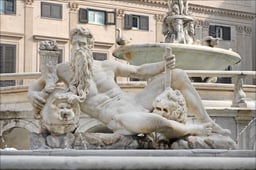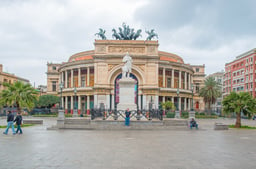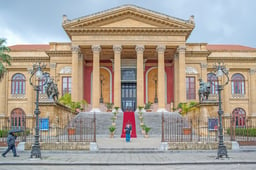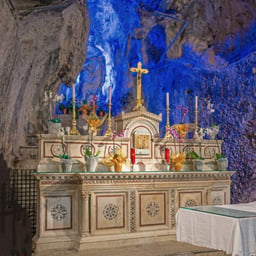Palermo
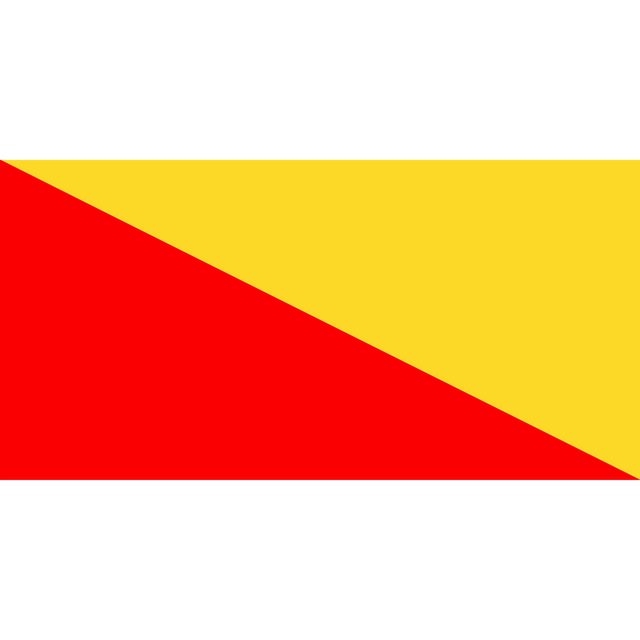
Palermo

Palermo Palermu(Sicilian) | |
|---|---|
| Comune di Palermo | |
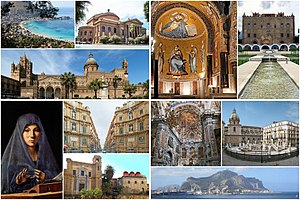 Clockwise from top: Mondello, Teatro Massimo, Cappella Palatina, Zisa, Cathedral, Virgin Annunciate of Antonello da Messina, Quattro Canti in Maqueda Street, Churches of Martorana and San Cataldo, Interior of Santa Caterina Church, Pretoria Square and Mount Pellegrino | |
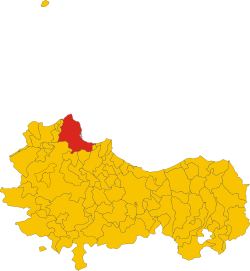 The municipality of Palermo within the province | |
Location of Palermo | |
| Coordinates:38°07′N 13°22′E [96] | |
| Country | Italy |
| Region | Sicily |
| Metropolitan city | Palermo (PA) |
| Founded | 736 BC |
| Government | |
| • Mayor | Leoluca Orlando (PD) |
| Area | |
| • Total | 160.59 km2(62.00 sq mi) |
| Elevation | 14 m (46 ft) |
| Population (2018-01-01)[2] | |
| • Total | 668,405 |
| • Density | 4,200/km2(11,000/sq mi) |
| Demonym(s) | Palermitano Panormito Palermitan (English) |
| Time zone | UTC+1 (CET) |
| • Summer (DST) | UTC+2 (CEST) |
| Postal code | 90100 |
| Dialing code | 091 |
| ISTAT code | 082053 [97] |
| Patron saint | Saint Rosalia, Saint Agata, Saint Oliva and Saint Benedict the Moor |
| Saint day | 14 July |
| Website | Official website [98] |
| Country of birth | Population |
| 5,567 | |
| 3,846 | |
| 3,056 | |
| 2,803 | |
| 1,757 | |
| 1,295 | |
| 1,184 | |
| 1,135 | |
| 1,034 | |
| other countries | each <600 |
Palermo (/pəˈlɛərmoʊ, -ˈlɜːr-/ pə-LAIR-moh, -LUR-,[3] Italian: [paˈlɛrmo] (listen); Sicilian: Palermu, locally [paˈlɛmmʊ]; Latin: Panormus, from Greek: Πάνορμος, romanized: Pánormos) is a city of Southern Italy, the capital of both the autonomous region of Sicily and the Metropolitan City of Palermo. The city is noted for its history, culture, architecture and gastronomy, playing an important role throughout much of its existence; it is over 2,700 years old. Palermo is located in the northwest of the island of Sicily, right by the Gulf of Palermo in the Tyrrhenian Sea.
The city was founded in 734 BC by the Phoenicians as Ziz. Palermo then became a possession of Carthage. Two Greek colonies were established, known collectively as Panormos or "All-Port"; the Carthaginians used this name on their coins after the 5th century BC. As Panormus, the town became part of the Roman Republic and Empire for over a thousand years. From 831 to 1072 the city was under Arab rule during the Emirate of Sicily when the city first became a capital. The Arabs shifted the Greek name into Bal'harm[4][5] (Arabic: بَلَرْم), the root for Palermo's present-day name. Following the Norman reconquest, Palermo became the capital of a new kingdom (from 1130 to 1816), the Kingdom of Sicily and the capital of the Holy Roman Empire under Emperor Frederick II and King Conrad IV.
The population of Palermo urban area is estimated by Eurostat to be 855,285, while its metropolitan area is the fifth most populated in Italy with around 1.2 million people. In the central area, the city has a population of around 676,000 people. The inhabitants are known as Palermitani or, poetically, panormiti. The languages spoken by its inhabitants are the Italian language and the Palermitano dialect of the Sicilian language.
Palermo is Sicily's cultural, economic and tourism capital. It is a city rich in history, culture, art, music and food. Numerous tourists are attracted to the city for its good Mediterranean weather, its renowned gastronomy and restaurants, its Romanesque, Gothic and Baroque churches, palaces and buildings, and its nightlife and music.[6] Palermo is the main Sicilian industrial and commercial center: the main industrial sectors include tourism, services, commerce and agriculture.[7] Palermo currently has an international airport, and a significant underground economy. In fact, for cultural, artistic and economic reasons, Palermo was one of the largest cities in the Mediterranean and is now among the top tourist destinations in both Italy and Europe. It is the main seat of the UNESCO World Heritage Site Arab-Norman Palermo and the Cathedral Churches of Cefalù and Monreale. The city is also going through careful redevelopment, preparing to become one of the major cities of the Euro-Mediterranean area.[8]
Roman Catholicism is highly important in Palermitano culture. The Patron Saint of Palermo is Santa Rosalia whose Feast Day is celebrated on 15 July. The area attracts significant numbers of tourists each year and is widely known for its colourful fruit, vegetable and fish markets at the heart of Palermo, known as Vucciria, Ballarò and Capo.[9]
Palermo Palermu(Sicilian) | |
|---|---|
| Comune di Palermo | |
 Clockwise from top: Mondello, Teatro Massimo, Cappella Palatina, Zisa, Cathedral, Virgin Annunciate of Antonello da Messina, Quattro Canti in Maqueda Street, Churches of Martorana and San Cataldo, Interior of Santa Caterina Church, Pretoria Square and Mount Pellegrino | |
 The municipality of Palermo within the province | |
Location of Palermo | |
| Coordinates:38°07′N 13°22′E [96] | |
| Country | Italy |
| Region | Sicily |
| Metropolitan city | Palermo (PA) |
| Founded | 736 BC |
| Government | |
| • Mayor | Leoluca Orlando (PD) |
| Area | |
| • Total | 160.59 km2(62.00 sq mi) |
| Elevation | 14 m (46 ft) |
| Population (2018-01-01)[2] | |
| • Total | 668,405 |
| • Density | 4,200/km2(11,000/sq mi) |
| Demonym(s) | Palermitano Panormito Palermitan (English) |
| Time zone | UTC+1 (CET) |
| • Summer (DST) | UTC+2 (CEST) |
| Postal code | 90100 |
| Dialing code | 091 |
| ISTAT code | 082053 [97] |
| Patron saint | Saint Rosalia, Saint Agata, Saint Oliva and Saint Benedict the Moor |
| Saint day | 14 July |
| Website | Official website [98] |
| Country of birth | Population |
| 5,567 | |
| 3,846 | |
| 3,056 | |
| 2,803 | |
| 1,757 | |
| 1,295 | |
| 1,184 | |
| 1,135 | |
| 1,034 | |
| other countries | each <600 |
Geography
Palermo lies in a basin, formed by the Papireto, Kemonia and Oreto rivers. The basin was named the Conca d'Oro (the Golden Basin) by the Arabs in the 9th century. The city is surrounded by a mountain range which is named after the city itself. These mountains face the Tyrrhenian Sea. Palermo is home to a natural port and offers excellent views to the sea, especially from Monte Pellegrino.
Climate

Gulf of Mondello seen from Monte Pellegrino
Palermo experiences a hot-summer subtropical Mediterranean climate (Köppen climate classification: Csa) that is mild with moderate seasonality. Summers are very long, hot and dry due to the domination of subtropical high pressure system, while winters experience moderate temperatures and changeable, rainy weather due to the polar front.[10] Temperatures in autumn and spring are usually mild. Palermo is one of the warmest cities in Europe (mainly due to its warm nights), with an average annual air temperature of 18.3 °C (64.9 °F), it's one of the warmest cities in Italy. It receives approximately 2,530 hours of sunshine per year. Snow is a rare occurrence having snowed about a dozen times since 1945.[11] Since the 1940s to nowadays there have been at least five times when considerable snowfall has occurred. In 1949 and in 1956, when the minimum temperature went down to 0 °C (32 °F), the city was blanketed by some centimetres of snow.[12] Snowfalls also occurred in 1981, 1986, 1999 and 2014.[13] The average annual temperature of the sea is above 19 °C (66 °F); from 14 °C (57 °F) in February to 26 °C (79 °F) in August. In the period from November to May, the average sea temperature exceeds 18 °C (64 °F) and in the period from June to October, the average sea temperature exceeds 21 °C (70 °F).[14]
| Climate data for Palermo-Boccadifalco Airport on the outskirts of the city (altitude: 117 m, satellite view [99] ), Extremes 1973-2016 | |||||||||||||
|---|---|---|---|---|---|---|---|---|---|---|---|---|---|
| Month | Jan | Feb | Mar | Apr | May | Jun | Jul | Aug | Sep | Oct | Nov | Dec | Year |
| Record high °C (°F) | 27.0 (80.6) | 29.0 (84.2) | 35.0 (95.0) | 34.6 (94.3) | 39.0 (102.2) | 44.0 (111.2) | 43.1 (109.6) | 42.4 (108.3) | 42.0 (107.6) | 35.2 (95.4) | 30.6 (87.1) | 29.2 (84.6) | 44.0 (111.2) |
| Average high °C (°F) | 14.7 (58.5) | 14.5 (58.1) | 16.4 (61.5) | 18.7 (65.7) | 23.3 (73.9) | 27.2 (81.0) | 29.8 (85.6) | 30.5 (86.9) | 27.5 (81.5) | 23.5 (74.3) | 19.0 (66.2) | 15.8 (60.4) | 21.8 (71.2) |
| Daily mean °C (°F) | 11.8 (53.2) | 11.5 (52.7) | 13.0 (55.4) | 15.1 (59.2) | 19.3 (66.7) | 23.2 (73.8) | 25.8 (78.4) | 26.6 (79.9) | 23.8 (74.8) | 20.1 (68.2) | 16.0 (60.8) | 13.0 (55.4) | 18.3 (64.9) |
| Average low °C (°F) | 8.9 (48.0) | 8.5 (47.3) | 9.6 (49.3) | 11.4 (52.5) | 15.3 (59.5) | 19.2 (66.6) | 21.7 (71.1) | 22.7 (72.9) | 20.1 (68.2) | 16.7 (62.1) | 12.9 (55.2) | 10.2 (50.4) | 14.8 (58.6) |
| Record low °C (°F) | −1.0 (30.2) | 0.9 (33.6) | −0.1 (31.8) | 3.2 (37.8) | 6.2 (43.2) | 12.1 (53.8) | 13.9 (57.0) | 15.0 (59.0) | 8.0 (46.4) | 8.0 (46.4) | 3.0 (37.4) | 1.6 (34.9) | −1.0 (30.2) |
| Average precipitation mm (inches) | 97.5 (3.84) | 109.9 (4.33) | 78.2 (3.08) | 65.1 (2.56) | 36.2 (1.43) | 17.9 (0.70) | 6.7 (0.26) | 31.8 (1.25) | 65.3 (2.57) | 105.6 (4.16) | 117.5 (4.63) | 123.7 (4.87) | 855.4 (33.68) |
| Average precipitation days(≥ 1 mm) | 9.0 | 9.6 | 8.7 | 8.6 | 4.1 | 1.9 | 1.2 | 2.4 | 5.4 | 8.2 | 10.4 | 12.0 | 81.5 |
| Source #1: Servizio Meteorologico[15] | |||||||||||||
| Source #2: Il Meteo[16] Extreme temperatures. | |||||||||||||
| Climate data for Palermo (Punta Raisi Airport), elevation: 21 m or 69 ft, 1961-1990 normals | |||||||||||||
|---|---|---|---|---|---|---|---|---|---|---|---|---|---|
| Month | Jan | Feb | Mar | Apr | May | Jun | Jul | Aug | Sep | Oct | Nov | Dec | Year |
| Average high °C (°F) | 14.8 (58.6) | 15.1 (59.2) | 16.1 (61.0) | 18.4 (65.1) | 21.8 (71.2) | 25.1 (77.2) | 28.3 (82.9) | 28.8 (83.8) | 26.6 (79.9) | 22.9 (73.2) | 19.3 (66.7) | 16.0 (60.8) | 21.1 (70.0) |
| Average low °C (°F) | 10.2 (50.4) | 10.1 (50.2) | 10.9 (51.6) | 12.9 (55.2) | 16.0 (60.8) | 19.7 (67.5) | 22.9 (73.2) | 23.6 (74.5) | 21.5 (70.7) | 17.8 (64.0) | 14.3 (57.7) | 11.5 (52.7) | 16.0 (60.7) |
| Average precipitation mm (inches) | 71.6 (2.82) | 65.4 (2.57) | 59.5 (2.34) | 44.1 (1.74) | 25.5 (1.00) | 12.2 (0.48) | 5.1 (0.20) | 13.3 (0.52) | 41.5 (1.63) | 98.0 (3.86) | 94.3 (3.71) | 80.0 (3.15) | 610.5 (24.02) |
| Average precipitation days(≥ 1.0 mm) | 9.7 | 10.0 | 8.7 | 6.1 | 3.2 | 1.6 | 0.8 | 1.6 | 4.1 | 8.3 | 9.4 | 10.8 | 74.3 |
| Average relative humidity (%) | 73 | 72 | 72 | 72 | 72 | 71 | 69 | 71 | 72 | 71 | 70 | 73 | 72 |
| Source: NOAA[17] | |||||||||||||
Topography
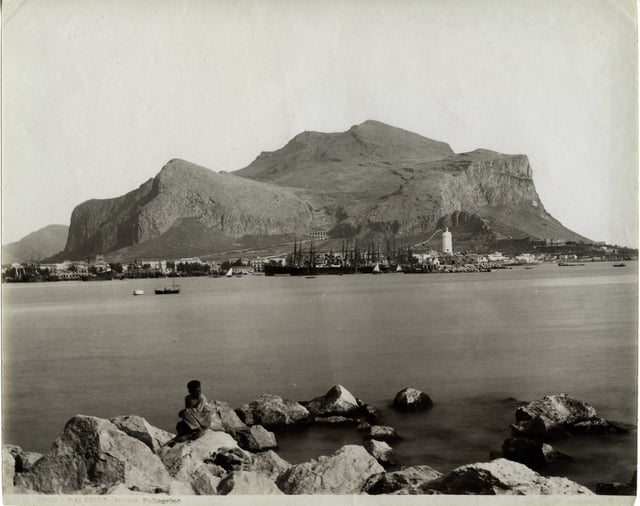
Monte Pellegrino pictured at the end of the 19th century; the mountain is visible from everywhere in the city
Palermo is surrounded by mountains, which form a cirque around the city. Some districts of the city are divided by the mountains themselves. Historically, it was relatively difficult to reach the inner part of Sicily from the city because of the mounts. The tallest peak of the range is La Pizzuta, about 1,333 metres (4,373 ft) high. However, historically, the most important mount is Monte Pellegrino, which is geographically separated from the rest of the range by a plain. The mount lies right in front of the Tyrrhenian Sea. Monte Pellegrino's cliff was described in the 19th century by Johann Wolfgang von Goethe, as "the most beautiful promontory in the world", in his essay "Italian Journey".
Rivers

View of Palermo from Monte Pellegrino
Today both the Papireto river and the Kemonia are covered up by buildings. However, the shape of the former watercourses can still be recognised today, because the streets that were built on them follow their shapes. Today the only waterway not drained yet is the Oreto river that divides the downtown of the city from the western uptown and the industrial districts. In the basins there were, though, many seasonal torrents that helped formed swampy plains, reclaimed during history; a good example of which can be found in the borough of Mondello.
Districts
| Municipality | Quarters |
|---|---|
| I | Kalsa, Albergheria, Seralcadio & La Loggia |
| II | Settecannoli, Brancaccio & Ciaculli-Oreto |
| III | Villagrazia-Falsomiele & Stazione-Oreto |
| IV | Montegrappa, S. Rosalia, Cuba, Calafatimi, Mezzomonreale, Villa Tasca-Altarello & Boccadifalco |
| V | Zisa, Noce, Uditore-Passo di Rigano & Borgo Nuovo |
| VI | Cruillas, S. Giovanni Apostolo, Resuttana & San Lorenzo |
| VII | Pallavicino, Tommaso Natale, Sferracavallo, Partanna Mondello, Arenella, Vergine Maria & San Filippo Neri (formerly known as ZEN) |
| VIII | Politeama, Malaspina-Palagonia, Libertà & Monte Pellegrino |
Shown above are the thirty five quarters of Palermo: these thirty five neighbourhoods or "quartiere" as they are known, are further divided into eight governmental community boards.[18]
Landmarks
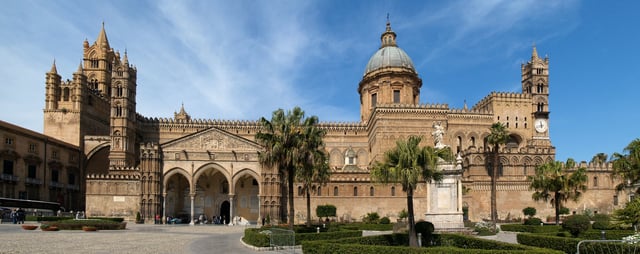
Palermo Cathedral
Palermo has a large architectural heritage and is notable for its many Norman buildings.
Churches
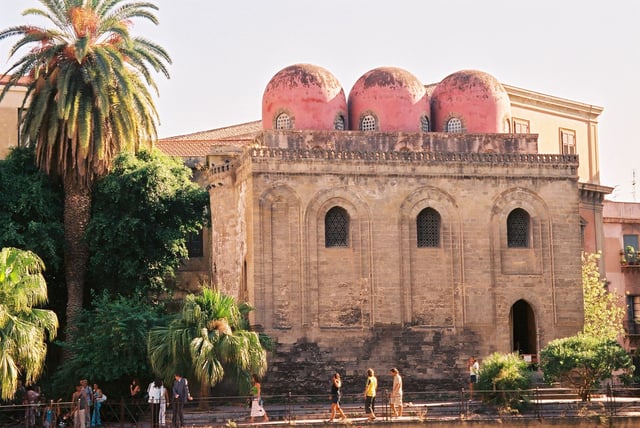
San Cataldo's Church.

Chiesa della Martorana.

Church of Saint Catherine.
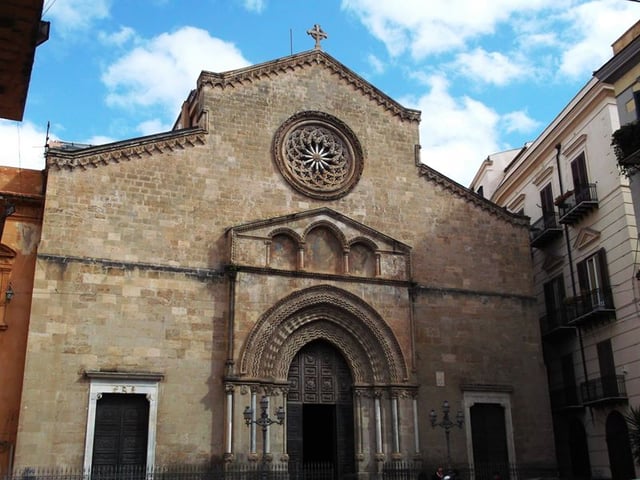
Church of San Francesco d'Assisi.
Palermo Cathedral: Located at Corso Vittorio Emanuele, corner Via Matteo Bonello, its long history has led to an accumulation of different architectural styles, the latest being the 18th century.
Cappella Palatina, the 12th century chapel of the Palazzo dei Normanni, has outstanding mosaics in both Western and the Eastern traditions and a roof by Saracen craftsmen.
San Giovanni dei Lebbrosi
San Giovanni degli Eremiti (St. John of the Hermit Order): Located near the Palazzo dei Normanni, a 12th-century church notable for its bright red domes, a remnant of Arab influence in Sicily. In his Diary of an Idle Woman in Sicily, F. Elliot described it as "... totally oriental... it would fit well in Baghdad or Damascus". The bell tower is an example of Gothic architecture.
Chiesa della Martorana: Also known as Santa Maria dell'Ammiraglio (St Mary of the Admiral), the church is annexed to the next-door church of San Cataldo and overlooks the Piazza Bellini in central Palermo. The original layout was a compact cross-in-square ("Greek cross plan"), a common south Italian and Sicilian variant of the middle Byzantine period church style. Three eastern apses adjoin directly to the naos, instead of being separated by an additional bay, as was usual in eastern Byzantine architecture.[19] The bell tower, lavishly decorated, still serves as the main entrance to the church. The interior decoration is elaborate, and includes Byzantine mosaics.
San Cataldo: Church, on the central Piazza Bellini, which is a good example of Norman architecture.
Santa Maria della Gancia
Santa Caterina: This church is located behind Piazza Pretoria and built between 1566 and 1596 in the baroque style.
Santa Maria della Catena: This church was built between 1490-1520. Designed by Matteo Carnilivari: The name derives from chains that were once attached to one of the walls.
San Domenico: Located near Via Roma, it is known as the “Pantheon of illustrious Sicilians”.
San Giuseppe dei Teatini: Located near the Quattro Canti, it is an example of Sicilian Baroque.
Oratorio di San Lorenzo Working in stucco, Rococo sculptor Giacomo Serpotta, his brother Giuseppe and his son Procopio, decorated the church (1690/98–1706) with such a profusion of statuary, and an abundance of putti, the walls appear alive. In October 1969, two thieves removed Caravaggio's Nativity with St. Francis and St. Lawrence from its frame. It has never been recovered.[20][21]
Oratorio del Rosario: Completed by Giacomo Serpotta in (1710–17)
Santa Teresa alla Kalsa, which derives its name from Al-Khalisa, an Arabic term meaning elected, was constructed between 1686-1706 over the former Emir's residence, is one of the best examples of Sicilian Baroque. It has a single, airy nave, with stucco decorations from the early 18th century.
Santa Maria dello Spasimo was built in 1506 and later turned into a hospital. This church inspired Raphael to paint his famous Sicilia's Spasimo, now in the Museo del Prado. The church today is a fascinating open-air auditorium, which occasionally houses exhibitions and musical shows.
Church of the Gesu (Church of Jesus): Located in the city centre, the church was built in 1564 in the late-Renaissance style by the Jesuits. It was built over a pre-existing convent of Basilian monks. Alterations in 1591 were completed in a Sicilian Baroque. The church was heavily damaged after the 1943 bombings, which destroyed most of the frescos. The interior has a Latin cross plan with a nave and two aisles, and has a particularly rich decoration of marbles, intarsia and stuccoes, especially in St Anne's Chapel. At the right is the Casa Professa, with a 1685 portal and a precious 18th century cloister. The building has been home to the Municipal Library since 1775.
San Francesco di Assisi: this church was built between 1255 and 1277 in what was once the market district of the city, at the site of two pre-existing churches and was largely renovated in the 15th, 16th, 18th and 19th centuries, the last after an earthquake. After the 1943 bombings, the church was restored to its Medieval appearance, which now includes part of the original building such as part of the right side, the apses and the Gothic portal in the façade. The interior has a typical Gothic flavour, with a nave and two aisles separated by two rows of cylindrical pilasters. Some of the chapels are in Renaissance style, as well as the late 16th century side portals. The church includes precious sculptures by Antonio, Giacomo Gagini and Francesco Laurana. Of note are also statues built by Giacomo Serpotta in 1723.
Church of the Magione: Officially known as the church of the Holy Trinity. This church was built in the Norman style in 1191 by Matteo d'Ajello, who donated it to the Cistercian monks.
Palaces and museums

Palazzo dei Normanni, seat of the Sicilian Regional Assembly.
Palazzo dei Normanni (the Norman Palace), a notable example of Norman architecture, this palace houses the Cappella Palatina.
Zisa (1160) and Cuba, magnificent castles/houses historically used by the kings of Palermo for hunting. The Zisa today houses the Islamic museum. The Cuba was once encircled by water.
Palazzo Natoli
Palazzo Chiaramonte
Palazzo Abatellis. Built at the end of the 15th century for the prefect of the city, Francesco Abatellis. It is a massive though elegant construction, in typical Catalan Gothic style, with Renaissance influences. The Gallery houses an Eleonora of Aragon bust by Francesco Laurana (1471) and the Malvagna Triptych (c. 1510), by Jan Gossaert and the famous Annunziata by Antonello da Messina.
The Regional Archeological Museum Antonio Salinas is one of the main museums of Italy: it includes numerous remains from Etruscan, Carthaginian, Roman and Hellenistic civilisations. It houses all the decorative remains from the Sicilian temples of Segesta and Selinunte.
Palazzina Cinese, royal residence of the House of Bourbon-Two Sicilies and location of the Ethnografic Museum of Sicily.
City walls
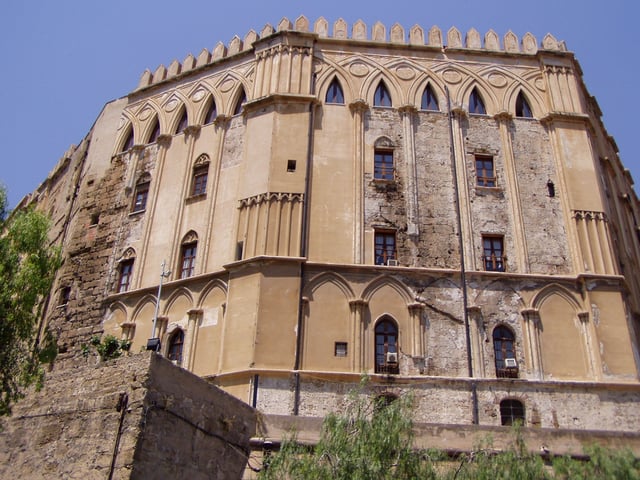
The Palazzo dei Normanni
Palermo has at least two rings of city walls, many pieces of which still survive. The first ring surrounded the ancient core of the Phoenician city – the so-called Palaeopolis (in the area east of Porta Nuova) and the Neapolis. Via Vittorio Emanuele was the main road east–west through this early walled city. The eastern edge of the walled city was on Via Roma and the ancient port in the vicinity of Piazza Marina. The wall circuit was approximately Porto Nuovo, Corso Alberti, Piazza Peranni, Via Isodoro, Via Candela, Via Venezia, Via Roma, Piazza Paninni, Via Biscottari, Via Del Bastione, Palazzo dei Normanni and back to Porto Nuovo.
In the medieval period the walled city was expanded. Via Vittorio Emanuele continued to be the main road east–west through the walled city. The west gate was still Porta Nuova, the walls continued to Corso Alberti, to Piazza Vittorio Emanuele Orlando where it turned east along Via Volturno to Piazza Verdi and along the line of Via Cavour. At this northeast corner there was a defence, Castello a Mare, to protect the port at La Cala. A huge chain was used to block La Cala with the other end at Santa Maria della Catena (St Mary of the Chain). The sea-side wall was along the western side of Foro Italico Umberto. The wall turns west along the northern side of Via Abramo Lincoln, continues along Corso Tukory. The wall turns north approximately on Via Benedetto, to Palazzo dei Normanni and back to Porta Nuova.[22]
Several gates in the city wall survive. Images of the wall can be seen here.[23]
Opera houses
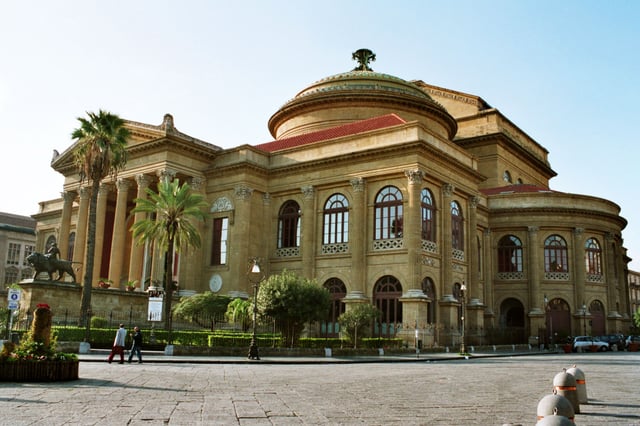
Teatro Massimo opera house.
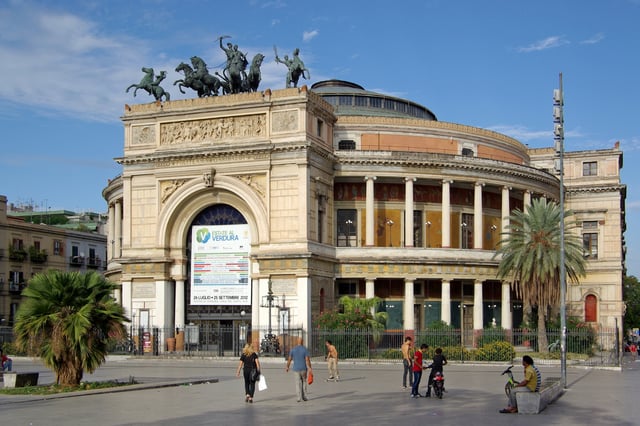
Teatro Politeama.
Up until the beginning of 20th century there were hundreds of small opera theatres known as magazzeni in the city of Palermo.
The Teatro Massimo ("Greatest Theatre") was opened in 1897. It is the biggest in Italy (8,000 m2, 86,000 sq ft), and one of the largest of Europe (the third after the Paris Opera and the Vienna State Opera), renowned for its perfect acoustics. Enrico Caruso sang in a performance of La Gioconda during the opening season, returning for Rigoletto at the very end of his career. Closed for renovation from 1974 until 1997, it is now restored and has an active schedule.
The Teatro Politeama was built between 1867 and 1874.
Squares
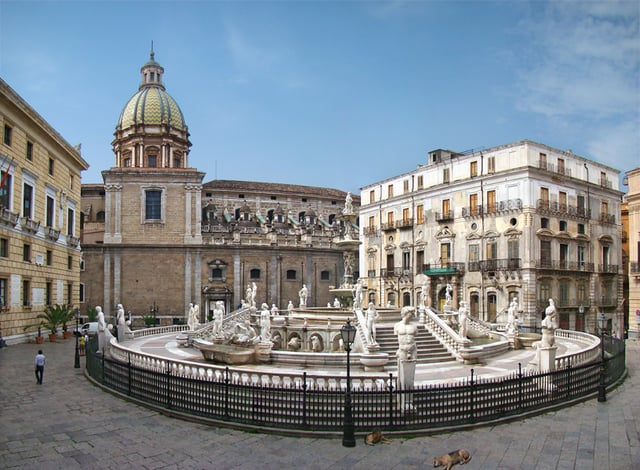
Piazza Pretoria.
Quattro Canti is a small square at the crossing of the ancient main roads (now: Corso Vittorio Emanuele and Via Maqueda) dividing the town into its quarters (mandamenti). The buildings at the corner have diagonal baroque façades so the square has an almost octagonal form.
Piazza Pretoria was planned in the 16th century near the Quattro Canti as the site of a fountain by Francesco Camilliani, the Fontana Pretoria
Other sights
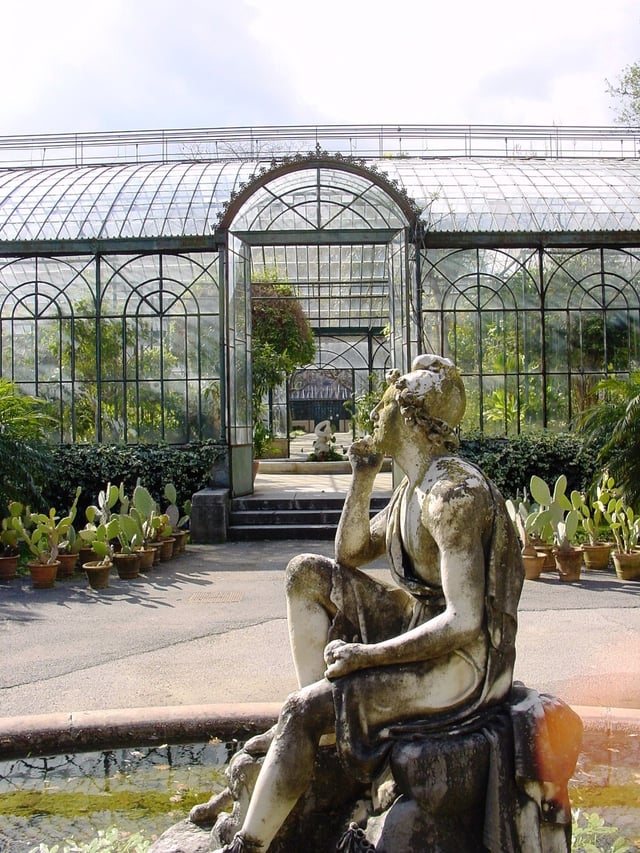
Palermo Botanical Garden: the Winter Garden greenhouses.
The cathedral has a heliometer (solar observatory) dating to 1690, one of a number[24] built in Italy in the 17th and 18th centuries. The device itself is quite simple: a tiny hole in one of the minor domes acts as pinhole camera, projecting an image of the sun onto the floor at solar noon (12:00 in winter, 13:00 in summer). There is a bronze line, la Meridiana, on the floor, running precisely north–south. The ends of the line mark the positions as at the summer and winter solstices; signs of the zodiac show the various other dates throughout the year.
The purpose of the instrument was to standardise the measurement of time and the calendar. The convention in Sicily had been that the (24‑hour) day was measured from the moment of dawn, which of course meant that no two locations had the same time and, more importantly, did not have the same time as in St. Peter's Basilica in Rome. It was also important to know when the vernal equinox occurred, to provide the correct date for Easter.
The Orto botanico di Palermo (Palermo Botanical Garden), founded in 1785, is the largest in Italy with a surface of 10 hectares (25 acres).
Close to the city is the 600-metre-high (2,000 ft) Monte Pellegrino, offering a panorama of the city, its surrounding mountains and the sea.
Another good panoramic viewpoint is the promontory of Monte Gallo (586 m, 1,923 ft), near Mondello Beach.[25]
[[INLINE_IMAGE|//upload.wikimedia.org/wikipedia/commons/thumb/d/d9/Palermo_0579_2013.jpg/317px-Palermo_0579_2013.jpg|//upload.wikimedia.org/wikipedia/commons/thumb/d/d9/Palermo_0579_2013.jpg/475px-Palermo_0579_2013.jpg 1.5x, //upload.wikimedia.org/wikipedia/commons/thumb/d/d9/Palermo_0579_2013.jpg/634px-Palermo_0579_2013.jpg 2x|Palermo 0579 2013.jpg|h140|w212]]
[[INLINE_IMAGE|//upload.wikimedia.org/wikipedia/commons/thumb/3/36/Palermo_0586_2013.jpg/315px-Palermo_0586_2013.jpg|//upload.wikimedia.org/wikipedia/commons/thumb/3/36/Palermo_0586_2013.jpg/472px-Palermo_0586_2013.jpg 1.5x, //upload.wikimedia.org/wikipedia/commons/thumb/3/36/Palermo_0586_2013.jpg/630px-Palermo_0586_2013.jpg 2x|Palermo 0586 2013.jpg|h140|w210]]
[[INLINE_IMAGE|//upload.wikimedia.org/wikipedia/commons/thumb/0/04/Palermo_0601_2013.jpg/146px-Palermo_0601_2013.jpg|//upload.wikimedia.org/wikipedia/commons/thumb/0/04/Palermo_0601_2013.jpg/218px-Palermo_0601_2013.jpg 1.5x, //upload.wikimedia.org/wikipedia/commons/thumb/0/04/Palermo_0601_2013.jpg/291px-Palermo_0601_2013.jpg 2x|Palermo 0601 2013.jpg|h140|w98]]
[[INLINE_IMAGE|//upload.wikimedia.org/wikipedia/commons/thumb/9/98/Palermo_0461_2013.jpg/210px-Palermo_0461_2013.jpg|//upload.wikimedia.org/wikipedia/commons/thumb/9/98/Palermo_0461_2013.jpg/315px-Palermo_0461_2013.jpg 1.5x, //upload.wikimedia.org/wikipedia/commons/thumb/9/98/Palermo_0461_2013.jpg/420px-Palermo_0461_2013.jpg 2x|Palermo 0461 2013.jpg|h140|w140]]
UNESCO World Heritage Sites
UNESCO World Heritage Sites include the Palazzo Reale with the Cappella Palatina, the Chiesa di San Giovanni degli Eremiti, the Chiesa di Santa Maria dell’Ammiraglio, the Chiesa di San Cataldo, the Cattedrale di Palermo, the Palazzo della Zisa and the Ponte dell’Ammiraglio.[26][27][28] This makes Italy the country with the most UNESCO world heritage sites,[29][30] and Sicily the region hosting the most within Italy.[31]
Demographics
| Historical population | ||
|---|---|---|
| Year | Pop. | ±% |
| 1861 | 199,911 | — |
| 1871 | 223,689 | +11.9% |
| 1881 | 244,898 | +9.5% |
| 1901 | 309,566 | +26.4% |
| 1911 | 339,465 | +9.7% |
| 1921 | 397,486 | +17.1% |
| 1931 | 379,905 | −4.4% |
| 1936 | 411,879 | +8.4% |
| 1951 | 490,692 | +19.1% |
| 1961 | 587,985 | +19.8% |
| 1971 | 642,814 | +9.3% |
| 1981 | 701,782 | +9.2% |
| 1991 | 698,556 | −0.5% |
| 2001 | 686,722 | −1.7% |
| 2008 (Est.) | 659,623 | −3.9% |
| Source: ISTAT 2001 | ||
In 2010, there were 1.2 million people living in the greater Palermo area, 655,875 of which resided in the City boundaries, of whom 47.4% were male and 52.6% were female. People under age 15 totalled 15.6% compared to pensioners who composed 17.2% of the population. This compares with the Italian average of 14.1% people under 15 years and 20.2% pensioners. The average age of a Palermo resident is 40.4 compared to the Italian average of 42.8. In the ten years between 2001 and 2010, the population of Palermo declined by 4.5%, while the population of Italy, as a whole, grew by 6.0%. The reason for Palermo's decline is a population flight to the suburbs, and to Northern Italy.[32] The current birth rate of Palermo is 10.2 births per 1,000 inhabitants compared to the Italian average of 9.3 births.
As of 2006, 97.79% of the population was of Italian descent. The largest immigrant group came from South Asia (mostly from Bangladesh and Sri Lanka): 0.80%, other European countries (mostly from Albania, Romania, Serbia, North Macedonia and Ukraine): 0.3%, and North Africa (mostly from Tunisia): 0.28%.[33]
History
Early history
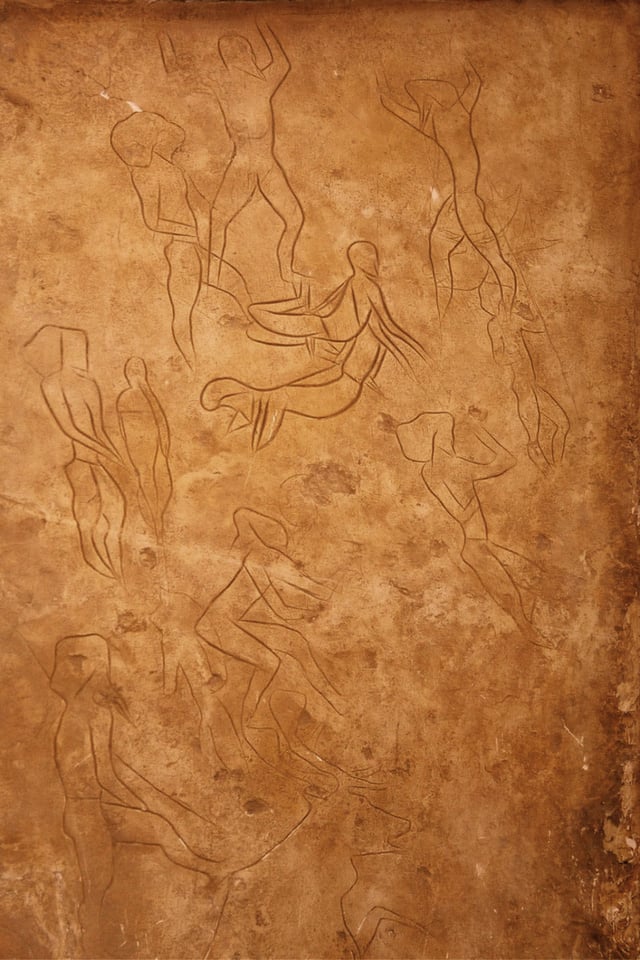
Mesolithic cave art at Addaura.
Evidence of human settlement in the area now known as Palermo goes back to at least the Mesolithic period, perhaps around 8000 BC, where a group of cave drawings at nearby Addaura from that period have been found.[35] The original inhabitants were Sicani people who, according to Thucydides, arrived from the Iberian Peninsula (perhaps Catalonia).[36][37]
Ancient period
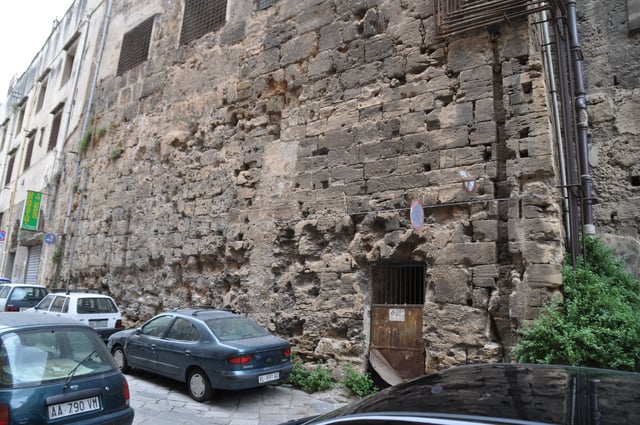
A brief stretch of Palermo's Phoenician defence wall, now enclosed in the Santa Caterina Monastery.
In 734 BC the Phoenicians, maritime traders from northern Canaan, built a small settlement on the natural harbor of Palermo, which became known as Ziz[38] (Punic: 𐤑𐤉𐤑, ṢYṢ).[39] It became one of the three main Phoenician colonies of Sicily, along with Motya and Soluntum. However, the remains of the Phoenician presence in the city are few and mostly preserved in the very populated center of the downtown area, making any excavation efforts costly and logistically difficult. The site chosen by the Phoenicians made it easy to connect the port to the mountains with a straight road that today has become Corso Calatifimi. This road helped the Phoenicians in trading with the populations that lived beyond the mountains that surround the gulf.
The first settlement is known as Paleapolis (Greek: Παλεάπολις), meaning "Old City", in order to distinguish it from a second settlement built during the 5th century BC, called Neapolis (Νεάπολις) or "New City". Neapolis was erected towards the east and along with it, monumental walls around the whole settlement were built to prevent attacks from foreign threats. Some part of this structure can still be seen in the Cassaro district. This district was named after the walls themselves; the word Cassaro deriving from the Arab al-qaṣr (castle, stronghold, see also alcázar). Along the walls there were few doors to access and exit the city, suggesting that trade even toward the inner part of the island occurred frequently. Moreover, according to some studies, it may be possible that there were some walls that divided the old city from the new one too. The colony developed around a central street (decumanus), cut perpendicularly by minor streets. This street today has become Corso Vittorio Emanuele.
Carthage was Palermo's major trading partner under the Phoenicians and the city enjoyed a prolonged peace during this period. Palermo came into contact with the Ancient Greeks between the 6th and the 5th centuries BC which preceded the Sicilian Wars, a conflict fought between the Greeks of Syracuse and the Phoenicians of Carthage for control over the island of Sicily. During this war the Greeks named the settlement Pánormos (Πάνορμος), meaning "all port" due to its large anchorage, from which the present name of the city developed. The Phoenicians began using the Greek name on the city's coinage from the 5th century BC.[40] It was from Palermo that Hamilcar I's fleet (which was defeated at the Battle of Himera) was launched.[41] In 409 BC the city was looted by Hermocrates of Syracuse. The Sicilian Wars ended in 265 BC when Carthage and Syracuse stopped warring and united in order to stop the Romans from gaining full control of the island during the First Punic War. In 276 BC,[42] during the Pyrrhic War, Panormos briefly became a Greek colony after being conquered by Pyrrhus of Epirus, but returned to Phoenician Carthage in 275 BC. In 254 BC Panormos was besieged and conquered by the Romans in the first battle of Panormus (the Latin name). Carthage attempted to reconquer Panormus in 251 BC but failed.
Middle Ages
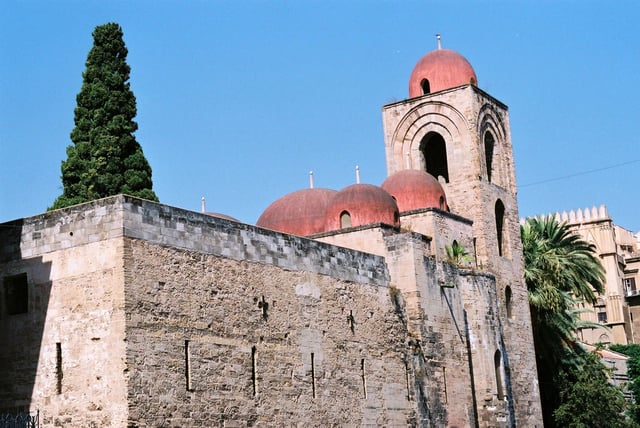
San Giovanni degli Eremiti, a church showing elements of Byzantine, Arabic, and Norman architecture.
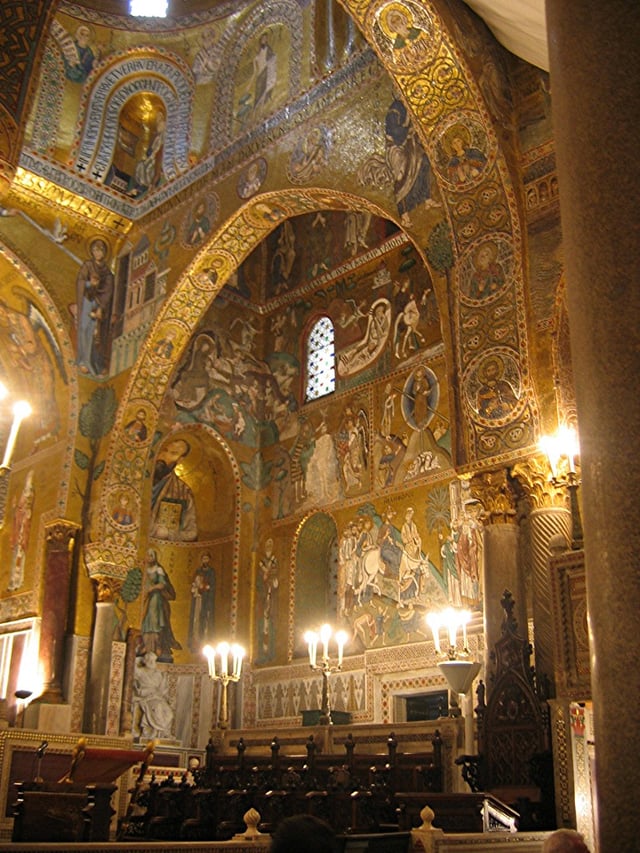
Cappella Palatina, decorated with Byzantine, Arabic and Norman elements.
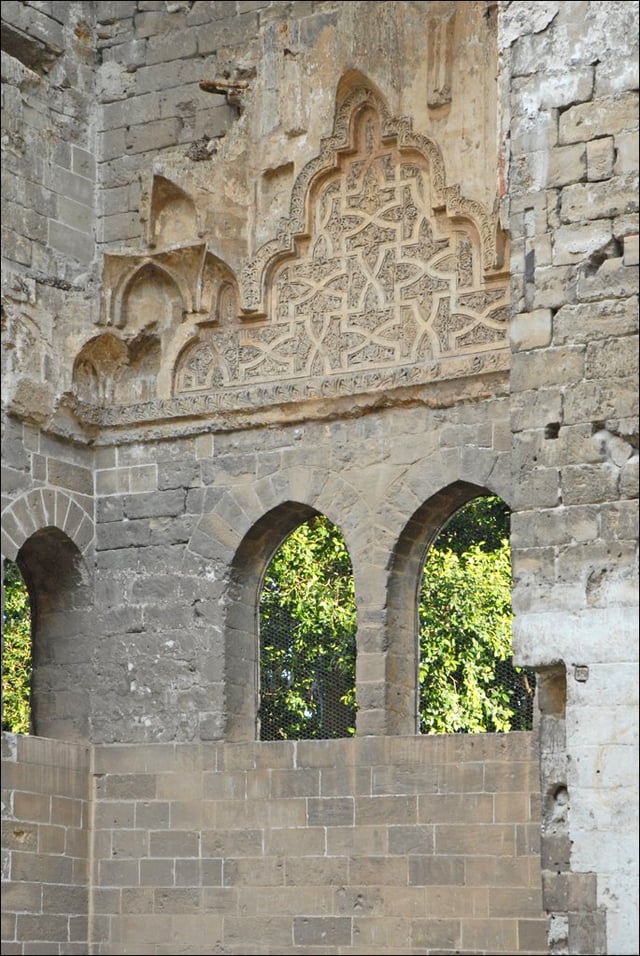
Arabesque on a wall of the Cuba Palace.
As the Roman Empire was falling apart, Palermo fell under the control of several Germanic tribes. The first were the Vandals in 440 AD under the rule of their king Geiseric. The Vandals had occupied all the Roman provinces in North Africa by 455 establishing themselves as a significant force.[43] They acquired Corsica, Sardinia and Sicily shortly afterwards. However, they soon lost these newly acquired possessions to the Ostrogoths. The Ostrogothic conquest under Theodoric the Great began in 488; Theodoric supported Roman culture and government unlike the Germanic Goths.[44] The Gothic War took place between the Ostrogoths and the Eastern Roman Empire, also known as the Byzantine Empire. Sicily was the first part of Italy to be taken under control of General Belisarius who was commissioned by Eastern Emperor. Justinian I solidified his rule in the following years.[45][46]
The Arabs took control of the island in 904, and the Emirate of Sicily was established.[47] Muslim rule on the island lasted for about 120 years.[48] Palermo (Bal'harm during Arab rule) displaced Syracuse as the capital of Sicily. It was said to have then begun to compete with Córdoba and Cairo in terms of importance and splendor.[49] For more than a hundred years Palermo was the capital of a flourishing emirate.[50] The Arabs also introduced many agricultural crops which remain a mainstay of Sicilian cuisine.[43]
After dynastic quarrels however, there was a Christian reconquest in 1072. The family who returned the city to Christianity were called the Hautevilles, including Robert Guiscard and his army, who is regarded as a hero by the natives.[47][51] It was under his nephew Roger II of Sicily that Norman holdings in Sicily and the southern part of the Italian Peninsula were promoted from the County of Sicily into the Kingdom of Sicily. The kingdom's capital was Palermo, with the King's Court held at the Palazzo dei Normanni. Much construction was undertaken during this period, such as the building of Palermo Cathedral. The Kingdom of Sicily became one of the wealthiest states in Europe.[52]
Sicily fell under the control of the Holy Roman Empire in 1194. Palermo was the preferred city of the Emperor Frederick II. Muslims of Palermo emigrated or were expelled during Holy Roman rule. After an interval of Angevin rule (1266–1282), Sicily came under control of the Aragon and Barcelona dynasties. By 1330, Palermo's population had declined to 51,000.[53] From 1479 until 1713 Palermo was ruled by the Kingdom of Spain, and again between 1717 and 1718. Palermo was also under Savoy control between 1713 and 1717 and 1718–1720 as a result of the Treaty of Utrecht. It was also ruled by Austria between 1720 and 1734.
Two Sicilies

The revolution in Palermo (12 January 1848).
After the Treaty of Utrecht (1713), Sicily was handed over to the House of Savoy, but by 1734 it was in Bourbon possession. Charles III chose Palermo for his coronation as King of Sicily. Charles had new houses built for the growing population, while trade and industry grew as well. However, by now Palermo was now just another provincial city as the Royal Court resided in Naples. Charles' son Ferdinand, though disliked by the population, took refuge in Palermo after the French Revolution in 1798. His son Alberto died on the way to Palermo and is buried in the city.
When the Kingdom of the Two Sicilies was founded, the original capital city was Palermo (1816) but a year later moved to Naples.
From 1820 to 1848 Sicily was shaken by upheavals, which culminated on 12 January 1848, with a popular insurrection, the first one in Europe that year, led by Giuseppe La Masa. A parliament and constitution were proclaimed. The first president was Ruggero Settimo. The Bourbons reconquered Palermo in 1849, and remained under their rule until the time of Giuseppe Garibaldi. The general entered Palermo with his troops (the “Thousands”) on 27 May 1860. After the plebiscite later that year Palermo, along with the rest of Sicily, became part of the new Kingdom of Italy (1861).
Italian unification and today
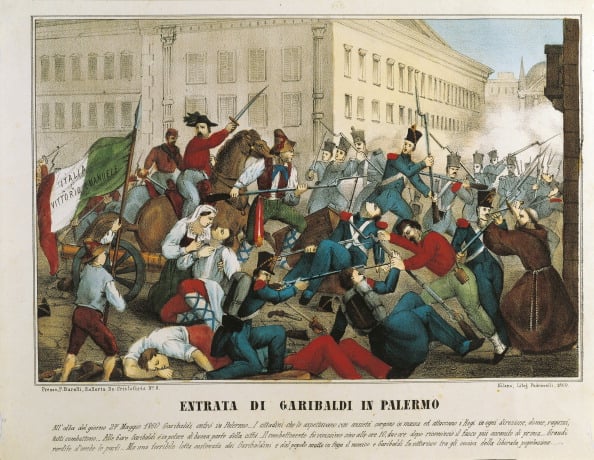
Giuseppe Garibaldi entering Palermo on 27 May 1860
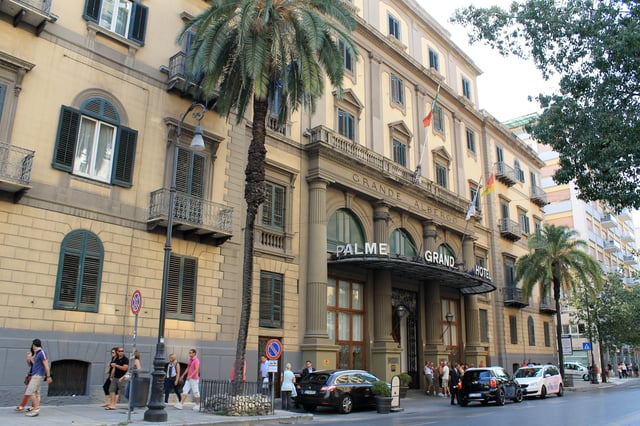
The historic Grand Hotel et des Palmes
The majority of Sicilians preferred independence to the Savoy kingdom; in 1866, Palermo became the seat of a week-long popular rebellion, which was finally crushed after Martial law was declared.[54] The Italian government blamed anarchists and the Church, specifically the Archbishop of Palermo, for the rebellion and began enacting anti-Sicilian and anti-clerical policies.[54] A new cultural, economic and industrial growth was spurred by several families, like the Florio, the Ducrot, the Rutelli, the Sandron, the Whitaker, the Utveggio, and others. In the early twentieth century, Palermo expanded outside the old city walls, mostly to the north along the new boulevards Via Roma, Via Dante, Via Notarbartolo, and Viale della Libertà. These roads would soon boast a huge number of villas in the Art Nouveau style. Many of these were designed by the architect Ernesto Basile. The Grand Hotel Villa Igiea, designed by Ernesto Basile for the Florio family, is a good example of Palermitan Art Nouveau. The huge Teatro Massimo was designed in the same period by Giovan Battista Filippo Basile, and built by the Rutelli & Machì building firm of the industrial and old Rutelli Italian family in Palermo, and was opened in 1897.
During the Second World War, Palermo was heavily bombed by the Allied air forces in 1942 and 1943, until its capture during the Allied invasion of Sicily on 22 July 1943.[55][56] The harbour (main objective of the air attacks) and the surrounding quarters were effectively destroyed, as was a considerable part of the city, with heavy civilian casualties.[57] When American troops entered Palermo in 1943 they were greeted with "a thunderous welcome by what seemed the entire population demonstrating their feelings about Facsist rule." The two captured Italian generals claimed that they were happy because in their view "the Sicilians were not human beings but animals".[58] Anti-sicilian prejudice was part of the fascist regime's world view, being promoted by pro-fascist newspapers, particularly in the north of Italy.[59]
In 1946 the city was declared the seat of the Regional Parliament, as capital of a Special Status Region (1947) whose seat is in the Palazzo dei Normanni.
A theme in the city's modern age has been the struggle against the Mafia, Red Brigades and outlaws such as Salvatore Giuliano, who controlled the neighbouring area of Montelepre. The Italian state effectively has had to share control of the territory, economically and administratively, with the Mafia.
The so-called "Sack of Palermo" is one of the major visible faces of the problem. The term is used to indicate the speculative building practices that have filled the city with poor buildings, mainly during the 1950s to the 1980s. The reduced importance of agriculture in the Sicilian economy has led to a massive migration to the cities, especially Palermo, which swelled in size, leading to rapid expansion towards the north. The regulatory plans for expansion was largely ignored in the boom. New parts of town appeared almost out of nowhere, but without parks, schools, public buildings, proper roads and the other amenities that characterise a modern city.
The Cosa Nostra has traditionally been the most powerful group in Palermo.[60] A CNN article in July 2019 indicated that Sicilian Mafia activity in Palermo was particularly notorious in one area: the town of Passo Rigano. "According to Italian police, the mafia not only engages in extortion there, but also has a large role in the town's legal economy -- with its involvement in business such as wholesale food supplies, online betting and gambling." The police investigation at the time also confirmed strong links between the Palermo area mafia and American organized crime, particularly the Gambino crime family.[61] According to La Repubblica, "Off they go, through the streets of Passo di Rigano, Boccadifalco, Torretta and at the same time, Brooklyn, Staten Island, New Jersey. Because from Sicily to the US, the old mafia has returned".[62]
Culture
Religion
Patron saints
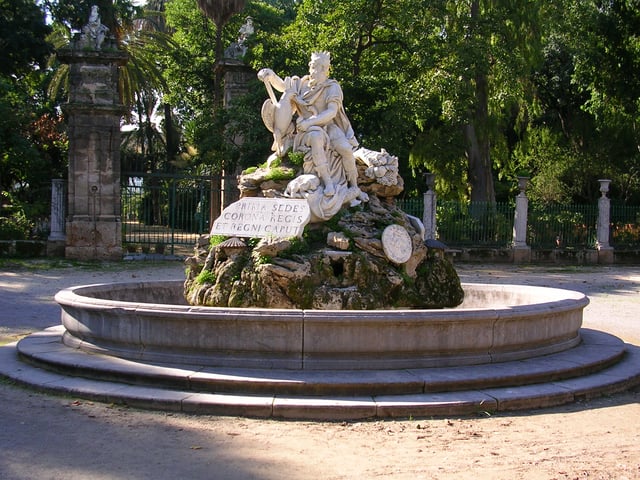
Genius of Palermo, the ancient patron of the city.
The patron saint of Palermo is Saint Rosalia, who is widely revered.
On 14 July, people in Palermo celebrate the annual Festino, the most important religious event of the year. The Festino is a procession which goes through the main street of Palermo to commemorate the miracle attributed to Saint Rosalia who, it is believed, freed the city from the Black Death in 1624. Her remains were discovered in a cave on Monte Pellegrino, and her remains were carried around the city three times, banishing the plague. There is a sanctuary marking the spot where her remains were found which can be reached via a scenic bus ride from the city.
Before 1624 Palermo had four patron saints, one for each of the four major parts of the city. They were Saint Agatha, Saint Christina, Saint Nympha and Saint Olivia.
Saint Lucy is also honoured with a peculiar celebration, during which the inhabitants of Palermo do not eat anything made with flour, but boil wheat in its natural state and use it to prepare a special dish called cuccìa. This commemorates the saving of the city from famine due to a miracle attributed to Saint Lucy; A ship full of grain mysteriously arrived in the city's harbour and the hungry population wasted no time in making flour but ate the grain as it arrived.
Saint Benedict the Moor is the heavenly protector of the city of Palermo.
The ancient patron of the city was the Genius of Palermo, genius loci and numen protector of the place, that became the laic patron of the modern Palermo.[63]
Sports

Stadio Renzo Barbera
Palermo hosts a professional football team, Società Sportiva Dilettantistica Palermo, commonly referred to as simply Palermo, who currently compete in Serie D, having been excluded from Serie B after the 2018-2019 season.
The Targa Florio was an open road endurance car race held near Palermo. Founded in 1906, it used to be one of the oldest sports car racing events until it was discontinued in 1977 due to safety concerns but has since run as a rallying event. Palermo was home to the grand depart of the 2008 Giro d'Italia. The initial stage was a 28.5-kilometre-long (17.7 mi) TTT (Team Time Trial).
The Internazionali Femminili di Palermo is an annual ladies professional tennis event held in the city, which is part of the WTA Tour.
Economy and infrastructure
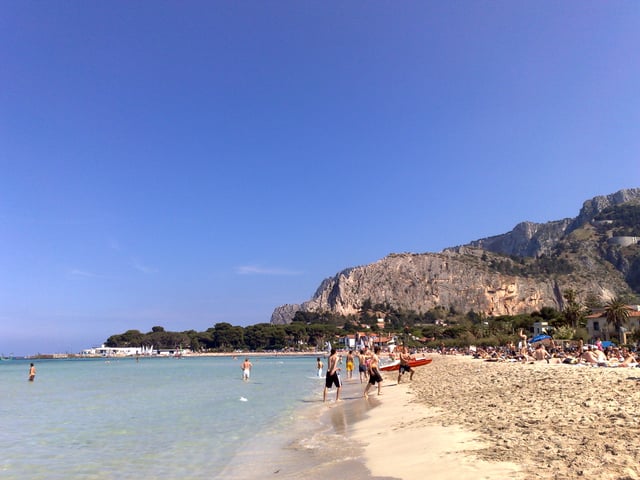
The Mondello Beach, one of the main tourist destinations
Being Sicily's administrative capital, Palermo is a centre for much of the region's finance, tourism and commerce. The city currently hosts an international airport,[64] and Palermo's economic growth over the years has brought the opening of many new businesses. The economy mainly relies on tourism and services, but also has commerce, shipbuilding and agriculture.[65] The city, however, still has high unemployment levels, high corruption and a significant black market empire (Palermo being the home of the Sicilian Mafia).
Public transport

Trains at Punta Raisi
Palermo has a local railway called the Palermo metropolitan railway service.[66]
Buses
Trams
Palermo has a public tram system finalized in 2015 and operated by AMAT. There are 4 lines:
Roccella — Central Station
Borgo Nuovo — Notarbartolo Station
CEP — Notarbartolo Station
Corso Calatafimi — Notarbartolo Station
Coaches
The local coach company, AST [101] , with its coaches totalling 35 lines, links Palermo to all of the main cities in Sicily.
Palermo Public Transportation Statistics
The average amount of time people spend commuting with public transit in Palermo, for example to and from work, on a weekday is 63 min. 14.% of public transit riders, ride for more than 2 hours every day. The average amount of time people wait at a stop or station for public transit is 23 min, while 48% of riders wait for over 20 minutes on average every day. The average distance people usually ride in a single trip with public transit is 4.4 km, while 3% travel for over 12 km in a single direction.[68]
Roads
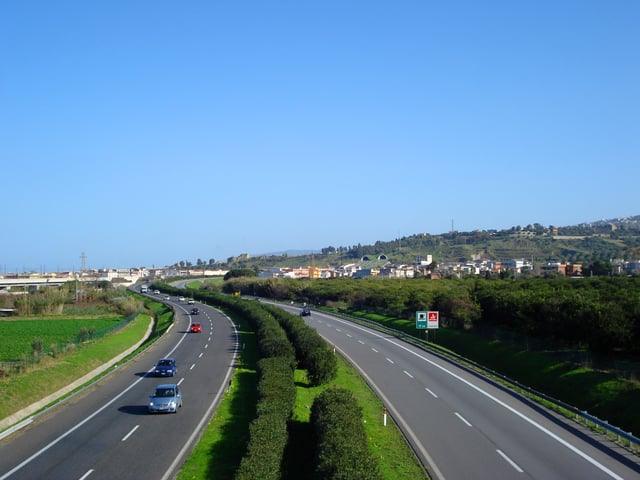
A20 that connects Palermo to Messina
Palermo is a key intersection on the Sicilian road network, being the junction between the eastern A19 motorway to Trapani, the southeastern A29 to airport and Mazara del Vallo and the southwestern A19 to Catania and A20 to Messina. Palermo is one of the main cities on European route E90. The three main national roads starting from Palermo are the SS113, SS121, SS186 and the SS624.
Airports
Palermo International Airport, known as Falcone-Borsellino Airport (formerly Punta Raisi Airport), is located 32 km (20 mi) west of Palermo. It is dedicated to Giovanni Falcone and Paolo Borsellino, two anti-mafia judges killed by the mafia in the early 1990s.
The airport's rail facility, known as Punta Raisi railway station, can be reached from Palermo Centrale, Palermo Notarbartolo and Palermo Francia railway stations.
Palermo-Boccadifalco Airport is the second airport of the city.
Port
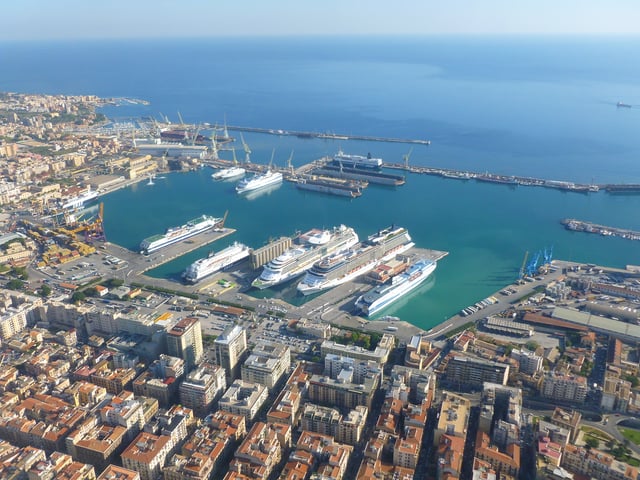
The port of Palermo

The port of Palermo, founded by the Phoenicians over 2,700 years ago, is, together with the port of Messina, the main port of Sicily. From here ferries link Palermo to Cagliari, Genoa, Livorno, Naples, Tunis and other cities and carry a total of almost 2 million passengers annually. It is also an important port for cruise ships. Traffic includes also almost 5 million tonnes (5.5 million short tons) of cargo and 80,000 TEUs yearly.[69] The port also has links to minor Sicilian islands such as Ustica and the Aeolian Islands (via Cefalù in summer). Inside the Port of Palermo there is a section known as "tourist marina" for sailing yachts and catamarans.
[[INLINE_IMAGE|//upload.wikimedia.org/wikipedia/commons/thumb/d/df/Palermo_0421_2013.jpg/639px-Palermo_0421_2013.jpg|//upload.wikimedia.org/wikipedia/commons/thumb/d/df/Palermo_0421_2013.jpg/959px-Palermo_0421_2013.jpg 1.5x, //upload.wikimedia.org/wikipedia/commons/thumb/d/df/Palermo_0421_2013.jpg/1277px-Palermo_0421_2013.jpg 2x|Palermo 0421 2013.jpg|h110|w426]]
[[INLINE_IMAGE|//upload.wikimedia.org/wikipedia/commons/thumb/f/f6/Palermo_0436_2013.jpg/502px-Palermo_0436_2013.jpg|//upload.wikimedia.org/wikipedia/commons/thumb/f/f6/Palermo_0436_2013.jpg/754px-Palermo_0436_2013.jpg 1.5x, //upload.wikimedia.org/wikipedia/commons/thumb/f/f6/Palermo_0436_2013.jpg/1003px-Palermo_0436_2013.jpg 2x|Palermo 0436 2013.jpg|h110|w335]]
National rail
The main railway station of Palermo is Palermo Centrale which links to the other cities of Sicily, including Agrigento, Trapani and Catania, and through Messina and the strait to the rest of Italy. The railways also connect to the Palermo airport with departures every thirty minutes.
Education
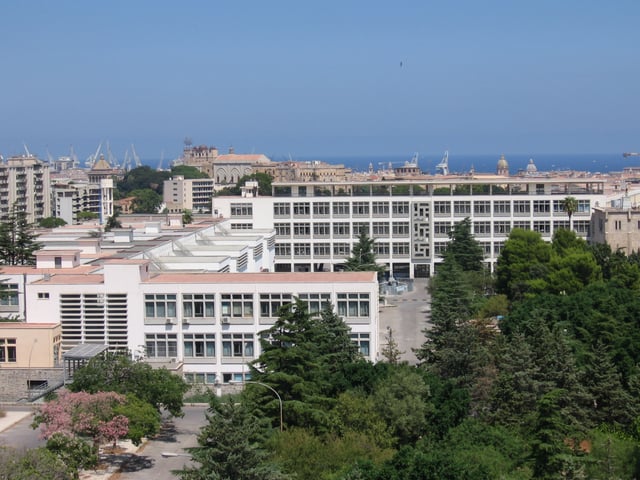
The University of Palermo
The local university is the University of Palermo, the island's second oldest university. It was officially founded in 1806, although historical records indicate that medicine and law have been taught there since the late 15th century. The Orto botanico di Palermo (Palermo botanical gardens) is home to the university's Department of Botany and is also open to visitors.
International relations
Twin towns and sister cities
Palermo is twinned with:
[[INLINE_IMAGE|//upload.wikimedia.org/wikipedia/commons/thumb/b/bd/Flag_of_Cuba.svg/23px-Flag_of_Cuba.svg.png|//upload.wikimedia.org/wikipedia/commons/thumb/b/bd/Flag_of_Cuba.svg/35px-Flag_of_Cuba.svg.png 1.5x, //upload.wikimedia.org/wikipedia/commons/thumb/b/bd/Flag_of_Cuba.svg/46px-Flag_of_Cuba.svg.png 2x|Cuba|h12|w23|thumbborder flagicon-img flagicon-img]] Santiago de Cuba[70]
[[INLINE_IMAGE|//upload.wikimedia.org/wikipedia/commons/thumb/0/0f/Flag_of_Georgia.svg/23px-Flag_of_Georgia.svg.png|//upload.wikimedia.org/wikipedia/commons/thumb/0/0f/Flag_of_Georgia.svg/35px-Flag_of_Georgia.svg.png 1.5x, //upload.wikimedia.org/wikipedia/commons/thumb/0/0f/Flag_of_Georgia.svg/45px-Flag_of_Georgia.svg.png 2x|Georgia (country)|h15|w23|thumbborder flagicon-img flagicon-img]] Tbilisi[70]
[[INLINE_IMAGE|//upload.wikimedia.org/wikipedia/en/thumb/a/a4/Flag_of_the_United_States.svg/23px-Flag_of_the_United_States.svg.png|//upload.wikimedia.org/wikipedia/en/thumb/a/a4/Flag_of_the_United_States.svg/35px-Flag_of_the_United_States.svg.png 1.5x, //upload.wikimedia.org/wikipedia/en/thumb/a/a4/Flag_of_the_United_States.svg/46px-Flag_of_the_United_States.svg.png 2x|United States|h12|w23|thumbborder flagicon-img flagicon-img]] Miami[70]
[[INLINE_IMAGE|//upload.wikimedia.org/wikipedia/commons/thumb/2/21/Flag_of_Colombia.svg/23px-Flag_of_Colombia.svg.png|//upload.wikimedia.org/wikipedia/commons/thumb/2/21/Flag_of_Colombia.svg/35px-Flag_of_Colombia.svg.png 1.5x, //upload.wikimedia.org/wikipedia/commons/thumb/2/21/Flag_of_Colombia.svg/45px-Flag_of_Colombia.svg.png 2x|Colombia|h15|w23|thumbborder flagicon-img flagicon-img]] Palermo[71]
[[INLINE_IMAGE|//upload.wikimedia.org/wikipedia/commons/thumb/0/00/Flag_of_Palestine.svg/23px-Flag_of_Palestine.svg.png|//upload.wikimedia.org/wikipedia/commons/thumb/0/00/Flag_of_Palestine.svg/35px-Flag_of_Palestine.svg.png 1.5x, //upload.wikimedia.org/wikipedia/commons/thumb/0/00/Flag_of_Palestine.svg/46px-Flag_of_Palestine.svg.png 2x|State of Palestine|h12|w23|thumbborder flagicon-img flagicon-img]] Khan Yunis[70]
[[INLINE_IMAGE|//upload.wikimedia.org/wikipedia/commons/thumb/6/6f/Flag_of_the_Democratic_Republic_of_the_Congo.svg/20px-Flag_of_the_Democratic_Republic_of_the_Congo.svg.png|//upload.wikimedia.org/wikipedia/commons/thumb/6/6f/Flag_of_the_Democratic_Republic_of_the_Congo.svg/31px-Flag_of_the_Democratic_Republic_of_the_Congo.svg.png 1.5x, //upload.wikimedia.org/wikipedia/commons/thumb/6/6f/Flag_of_the_Democratic_Republic_of_the_Congo.svg/40px-Flag_of_the_Democratic_Republic_of_the_Congo.svg.png 2x|Democratic Republic of the Congo|h15|w20|thumbborder flagicon-img flagicon-img]] Bukavu[72]
[[INLINE_IMAGE|//upload.wikimedia.org/wikipedia/en/thumb/f/f3/Flag_of_Russia.svg/23px-Flag_of_Russia.svg.png|//upload.wikimedia.org/wikipedia/en/thumb/f/f3/Flag_of_Russia.svg/35px-Flag_of_Russia.svg.png 1.5x, //upload.wikimedia.org/wikipedia/en/thumb/f/f3/Flag_of_Russia.svg/45px-Flag_of_Russia.svg.png 2x|Russia|h15|w23|thumbborder flagicon-img flagicon-img]] Yaroslavl[70]
[[INLINE_IMAGE|//upload.wikimedia.org/wikipedia/commons/thumb/f/fa/Flag_of_the_People%27s_Republic_of_China.svg/23px-Flag_of_the_People%27s_Republic_of_China.svg.png|//upload.wikimedia.org/wikipedia/commons/thumb/f/fa/Flag_of_the_People%27s_Republic_of_China.svg/35px-Flag_of_the_People%27s_Republic_of_China.svg.png 1.5x, //upload.wikimedia.org/wikipedia/commons/thumb/f/fa/Flag_of_the_People%27s_Republic_of_China.svg/45px-Flag_of_the_People%27s_Republic_of_China.svg.png 2x|China|h15|w23|thumbborder flagicon-img flagicon-img]] Chengdu[70]
[[INLINE_IMAGE|//upload.wikimedia.org/wikipedia/en/thumb/a/a4/Flag_of_the_United_States.svg/23px-Flag_of_the_United_States.svg.png|//upload.wikimedia.org/wikipedia/en/thumb/a/a4/Flag_of_the_United_States.svg/35px-Flag_of_the_United_States.svg.png 1.5x, //upload.wikimedia.org/wikipedia/en/thumb/a/a4/Flag_of_the_United_States.svg/46px-Flag_of_the_United_States.svg.png 2x|United States|h12|w23|thumbborder flagicon-img flagicon-img]] Monterey[73]
[[INLINE_IMAGE|//upload.wikimedia.org/wikipedia/commons/thumb/c/ce/Flag_of_Tunisia.svg/23px-Flag_of_Tunisia.svg.png|//upload.wikimedia.org/wikipedia/commons/thumb/c/ce/Flag_of_Tunisia.svg/35px-Flag_of_Tunisia.svg.png 1.5x, //upload.wikimedia.org/wikipedia/commons/thumb/c/ce/Flag_of_Tunisia.svg/45px-Flag_of_Tunisia.svg.png 2x|Tunisia|h15|w23|thumbborder flagicon-img flagicon-img]] Biserta[74]
[[INLINE_IMAGE|//upload.wikimedia.org/wikipedia/en/thumb/1/12/Flag_of_Poland.svg/23px-Flag_of_Poland.svg.png|//upload.wikimedia.org/wikipedia/en/thumb/1/12/Flag_of_Poland.svg/35px-Flag_of_Poland.svg.png 1.5x, //upload.wikimedia.org/wikipedia/en/thumb/1/12/Flag_of_Poland.svg/46px-Flag_of_Poland.svg.png 2x|Poland|h14|w23|thumbborder flagicon-img flagicon-img]] Gdańsk[75]
[[INLINE_IMAGE|//upload.wikimedia.org/wikipedia/commons/thumb/7/73/Flag_of_Romania.svg/23px-Flag_of_Romania.svg.png|//upload.wikimedia.org/wikipedia/commons/thumb/7/73/Flag_of_Romania.svg/35px-Flag_of_Romania.svg.png 1.5x, //upload.wikimedia.org/wikipedia/commons/thumb/7/73/Flag_of_Romania.svg/45px-Flag_of_Romania.svg.png 2x|Romania|h15|w23|thumbborder flagicon-img flagicon-img]] Timișoara[76]
[[INLINE_IMAGE|//upload.wikimedia.org/wikipedia/en/thumb/f/f3/Flag_of_Russia.svg/23px-Flag_of_Russia.svg.png|//upload.wikimedia.org/wikipedia/en/thumb/f/f3/Flag_of_Russia.svg/35px-Flag_of_Russia.svg.png 1.5x, //upload.wikimedia.org/wikipedia/en/thumb/f/f3/Flag_of_Russia.svg/45px-Flag_of_Russia.svg.png 2x|Russia|h15|w23|thumbborder flagicon-img flagicon-img]] Samara[77]
[[INLINE_IMAGE|//upload.wikimedia.org/wikipedia/commons/thumb/1/11/Flag_of_Lithuania.svg/23px-Flag_of_Lithuania.svg.png|//upload.wikimedia.org/wikipedia/commons/thumb/1/11/Flag_of_Lithuania.svg/35px-Flag_of_Lithuania.svg.png 1.5x, //upload.wikimedia.org/wikipedia/commons/thumb/1/11/Flag_of_Lithuania.svg/46px-Flag_of_Lithuania.svg.png 2x|Lithuania|h14|w23|thumbborder flagicon-img flagicon-img]] Vilnius[78]
[[INLINE_IMAGE|//upload.wikimedia.org/wikipedia/commons/thumb/0/00/Flag_of_Palestine.svg/23px-Flag_of_Palestine.svg.png|//upload.wikimedia.org/wikipedia/commons/thumb/0/00/Flag_of_Palestine.svg/35px-Flag_of_Palestine.svg.png 1.5x, //upload.wikimedia.org/wikipedia/commons/thumb/0/00/Flag_of_Palestine.svg/46px-Flag_of_Palestine.svg.png 2x|State of Palestine|h12|w23|thumbborder flagicon-img flagicon-img]] Bethlehem[79]
[[INLINE_IMAGE|//upload.wikimedia.org/wikipedia/en/thumb/b/ba/Flag_of_Germany.svg/23px-Flag_of_Germany.svg.png|//upload.wikimedia.org/wikipedia/en/thumb/b/ba/Flag_of_Germany.svg/35px-Flag_of_Germany.svg.png 1.5x, //upload.wikimedia.org/wikipedia/en/thumb/b/ba/Flag_of_Germany.svg/46px-Flag_of_Germany.svg.png 2x|Germany|h14|w23|thumbborder flagicon-img flagicon-img]] Düsseldorf[80]
[[INLINE_IMAGE|//upload.wikimedia.org/wikipedia/commons/thumb/f/fe/Flag_of_C%C3%B4te_d%27Ivoire.svg/23px-Flag_of_C%C3%B4te_d%27Ivoire.svg.png|//upload.wikimedia.org/wikipedia/commons/thumb/f/fe/Flag_of_C%C3%B4te_d%27Ivoire.svg/35px-Flag_of_C%C3%B4te_d%27Ivoire.svg.png 1.5x, //upload.wikimedia.org/wikipedia/commons/thumb/f/fe/Flag_of_C%C3%B4te_d%27Ivoire.svg/45px-Flag_of_C%C3%B4te_d%27Ivoire.svg.png 2x|Ivory Coast|h15|w23|thumbborder flagicon-img flagicon-img]] Grand-Bassam[81]
[[INLINE_IMAGE|//upload.wikimedia.org/wikipedia/en/thumb/c/c3/Flag_of_France.svg/23px-Flag_of_France.svg.png|//upload.wikimedia.org/wikipedia/en/thumb/c/c3/Flag_of_France.svg/35px-Flag_of_France.svg.png 1.5x, //upload.wikimedia.org/wikipedia/en/thumb/c/c3/Flag_of_France.svg/45px-Flag_of_France.svg.png 2x|France|h15|w23|thumbborder flagicon-img flagicon-img]] Montpellier[82]
[[INLINE_IMAGE|//upload.wikimedia.org/wikipedia/commons/thumb/7/73/Flag_of_Malta.svg/23px-Flag_of_Malta.svg.png|//upload.wikimedia.org/wikipedia/commons/thumb/7/73/Flag_of_Malta.svg/35px-Flag_of_Malta.svg.png 1.5x, //upload.wikimedia.org/wikipedia/commons/thumb/7/73/Flag_of_Malta.svg/45px-Flag_of_Malta.svg.png 2x|Malta|h15|w23|thumbborder flagicon-img flagicon-img]] La Valletta[83]
Twin City Trivia
In Robert Roswell Palmer and Joel Colton's majestic text-book for University education in the subject of history, A History of the Modern World Palermo is used to exemplify the south of Europe in context of the 1848 Revolutions, and Copenhagen for the opposite cardinal direction: "...from Copenhagen to Palermo and from Paris to Budapest."[84] In this manner, Palermo is twinned to Copenhagen and reversed.
Notable people
Eleonora Abbagnato, ballet dancer
Simonetta Agnello Hornby, writer
Mario Balotelli, footballer
Mario Bardi, painter
Paolo Borsellino, judge
Bruno Caruso, painter, illustrator, graphic designer and political activist
Marco Cecchinato, tennis player
Giovanni Falcone, judge
Franco Franchi, actor
Pietro Grasso, President of the Senate (Italy)
Ciccio Ingrassia, actor
Ugo La Malfa, politician
Sergio Mattarella, president of Italy
Vittorio Emanuele Orlando, Prime Minister of Italy
Amelia Pinto, opera singer
Salvatore Schillaci, footballer
Enzo Sellerio, photographer, publisher, and collector
Giacomo Serpotta, sculptor
Giuseppe Serpotta, sculptor
Antonio Starabba, Marchese di Rudinì, Prime Minister of Italy
Giuseppe Tomasi di Lampedusa, writer
Honorary citizens
People awarded the honorary citizenship of Palermo are:
See also
Outline of Palermo
Arab-Norman Palermo and the Cathedral Churches of Cefalù and Monreale
List of mayors of Palermo
Hugo Falcandus





